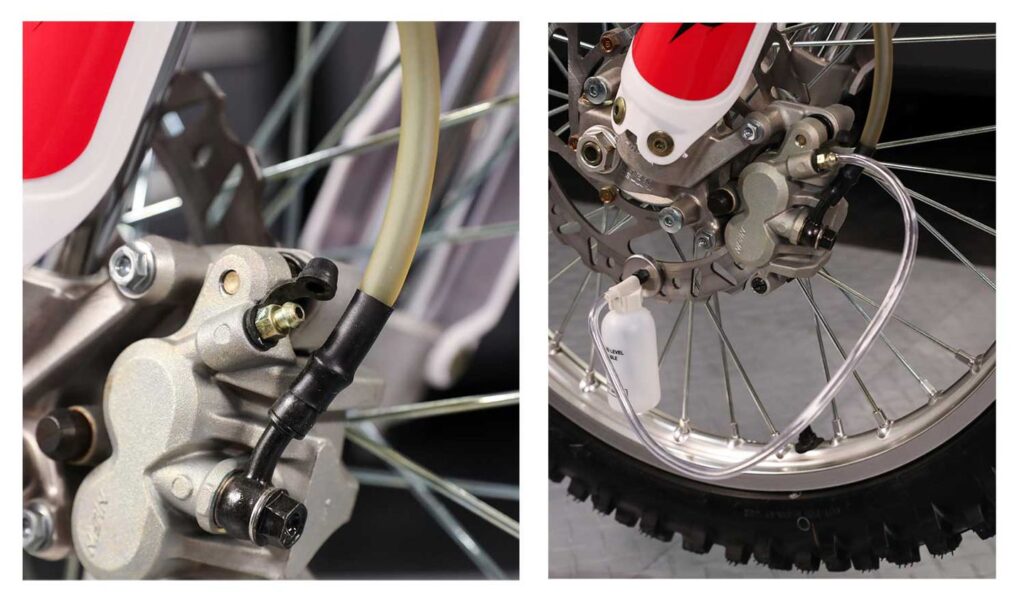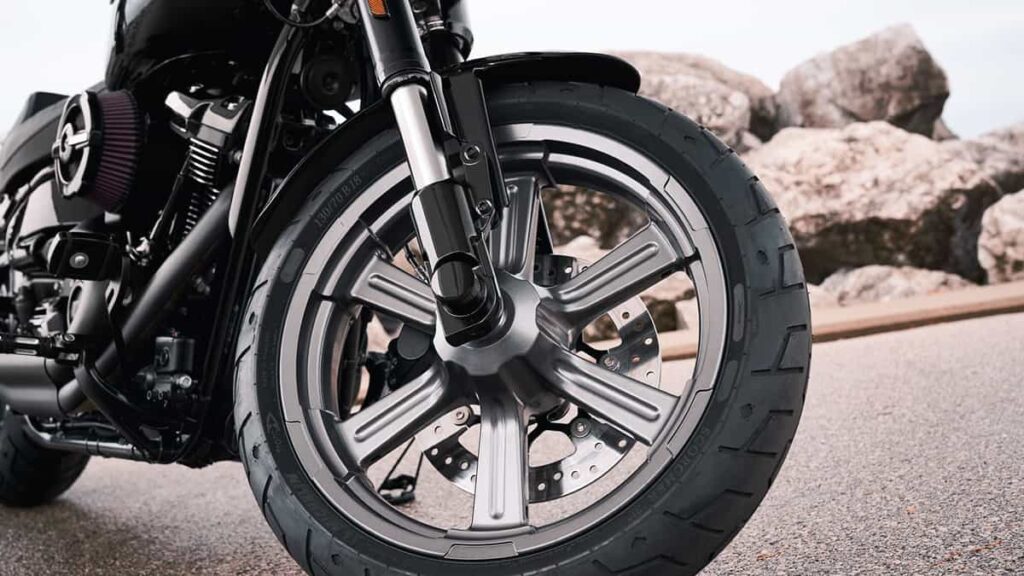Damaged motorcycle brakes will affect the safety of the rider during travel. Therefore, motorcycle owners need to regularly check and maintain to have timely treatment. The article Fix Motorcycle Brake Problems Easily will help you get more tips on how to fix a motorcycle brake problem.
How does the motorcycle disc brake system work?
A motorcycle disc brake system consists of a rotor, caliper, brake pads, and a hydraulic system. The rotor is a metal disc that is mounted to the wheel hub and rotates with the wheel. The caliper is a housing that contains the brake pads and is mounted over the rotor. The brake pads are made of a high-friction material and are pressed against the rotor when the brake lever or pedal is activated.

The hydraulic system consists of a master cylinder, brake fluid, and a system of tubes and hoses that connect the brake lever or pedal to the caliper. When the brake lever or pedal is activated, it pushes on a plunger in the master cylinder, which forces brake fluid through the tubes and hoses to the caliper. The brake fluid is a non-compressible liquid that transmits the force from the brake lever or pedal to the caliper.
When the brake fluid reaches the caliper, it pushes on a piston inside the caliper, which in turn pushes the brake pads against the rotor. The friction between the brake pads and the rotor slows the rotation of the wheel, bringing the motorcycle to a stop.
Motorcycle disc brake construction
A motorcycle disc brake consists of a rotor, a caliper, brake pads, and a hydraulic system. The rotor is a metal disc that is mounted to the wheel hub and rotates with the wheel. The caliper is a housing that contains the brake pads and is mounted over the rotor. The brake pads are made of a high-friction material and are pressed against the rotor when the brake lever or pedal is activated.
The hydraulic system consists of a master cylinder, brake fluid, and a system of tubes and hoses that connect the brake lever or pedal to the caliper. When the brake lever or pedal is activated, it pushes on a plunger in the master cylinder, which forces brake fluid through the tubes and hoses to the caliper. The brake fluid is a non-compressible liquid that transmits the force from the brake lever or pedal to the caliper.

The caliper is typically made of aluminum or some other lightweight material and is designed to fit over the rotor. It contains one or more pistons that are activated by the brake fluid when the brake lever or pedal is pressed. The pistons push the brake pads against the rotor, creating friction that slows the rotation of the wheel and brings the motorcycle to a stop.
The brake pads are made of a high-friction material, such as an organic, semi-metallic, or metallic compound. They are held in place in the caliper by a backing plate and are pressed against the rotor when the brake lever or pedal is activated. The brake pads are designed to wear down over time and need to be replaced when they become too thin.
The hydraulic system consists of a master cylinder, brake fluid, and a system of tubes and hoses that connect the brake lever or pedal to the caliper. The master cylinder is a hydraulic pump that is activated by the brake lever or pedal and creates pressure in the brake fluid.
The brake fluid is a non-compressible liquid that transmits the force from the brake lever or pedal to the caliper. The tubes and hoses are used to route the brake fluid from the master cylinder to the caliper. This is the next information in Fix Motorcycle Brake Problems Easily.
Common problems of motorcycle disc brakes
Several common problems can occur with motorcycle disc brakes. Some of the most common issues in Fix Motorcycle Brake Problems Easily include:
Brake pads wearing out: Brake pads are designed to wear down over time and will eventually need to be replaced. If the brake pads become too thin, they may not provide sufficient friction to bring the motorcycle to a stop, leading to longer stopping distances and reduced brake performance.
Brake fluid leaks: If the tubes or hoses that carry the brake fluid become damaged or develop a leak, the brake fluid can escape, reducing the hydraulic pressure in the system. This can lead to reduced brake performance and, in severe cases, complete failure of the brakes.

Air in the brake lines: If air gets into the brake lines, it can reduce the effectiveness of the brakes. This can occur if the brake fluid level gets too low, causing air to be drawn into the system.
Corroded or contaminated brake fluid: Over time, brake fluid can become contaminated with water or other contaminants, which can reduce its effectiveness and lead to reduced brake performance.
Bent or damaged rotors: If the rotors become bent or damaged, they may not function properly and can lead to reduced brake performance or complete brake failure.
Malfunctioning caliper: If the caliper becomes damaged or fails, it may not function properly, leading to reduced brake performance or complete brake failure.
If you experience any issues with your motorcycle disc brakes, it is important to have them inspected and repaired by a qualified mechanic to ensure the safety of the vehicle. This is the next information in Fix Motorcycle Brake Problems Easily.
How to maintain motorcycle disc brakes at home
Here are some steps you can take to maintain your motorcycle disc brakes at home:
Check the brake fluid level regularly: It is important to keep the brake fluid level at the correct level to ensure the brakes are functioning properly. Use a clean, dry cloth to wipe the brake fluid reservoir clean and check the level. If it is low, add brake fluid until it reaches the correct level.
Inspect the brake pads regularly: The brake pads should be inspected regularly for wear. If the brake pads are thin or worn down, they should be replaced.

Clean the rotors: Dirt and debris can accumulate on the rotors, which can affect brake performance. Use a clean, dry cloth to wipe the rotors clean. Avoid using any solvents or abrasive materials, as they can damage the rotors.
Check the brake hoses and lines: Inspect the brake hoses and lines for any signs of wear or damage. If you notice any cracks, kinks, or leaks, have them replaced by a qualified mechanic.
Check the caliper: Inspect the caliper for any signs of damage or wear. If you notice any problems, have the caliper repaired or replaced by a qualified mechanic.
Bleed the brakes: Over time, air can get into the brake lines, which can reduce the effectiveness of the brakes. To remove the air from the lines, you will need to bleed the brakes. This process involves attaching a hose to the bleed valve and opening the valve to allow the air to escape.
Remember to always use caution when working on your motorcycle and follow all safety guidelines. If you are not comfortable performing these tasks, it is recommended to have them done by a qualified mechanic. This is the next information in Fix Motorcycle Brake Problems Easily.
Hopefully, the article Fix Motorcycle Brake Problems Easily will provide you with useful information.

